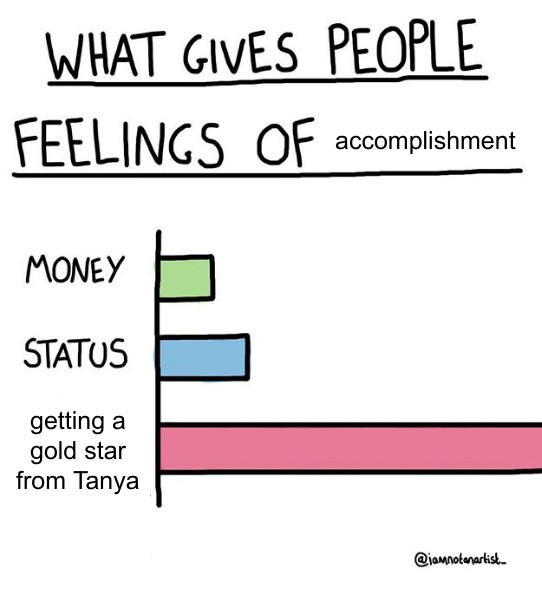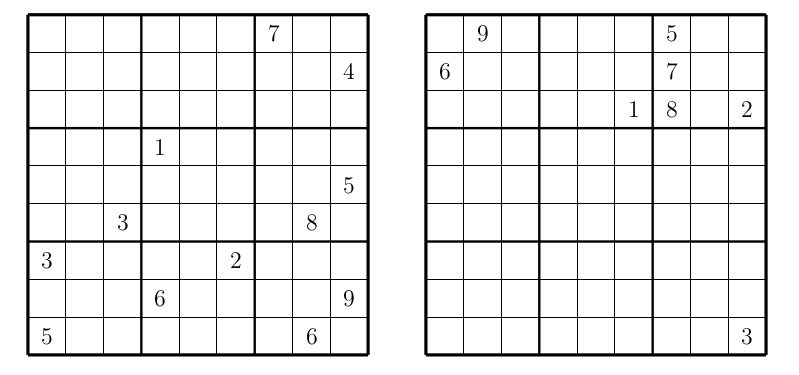28th November 2021, 01:54 pm
* * *
I surveyed many people who had played Russian roulette. Seems like the probability of dying is actually 0%.
* * *
What has the probability of one in five million?
Zero: there’s no 1 in 5000000. Only a five and six zeros.
* * *
Two classmates:
—What did you think of our probability exam yesterday?
—All means to an end.
* * *
My classmate didn’t study for our test in probability.
“I’ll take my chances”, he said.
* * *
I saw my math teacher with a piece of graph paper yesterday. I think he must be plotting something.
* * *
Not all math puns are terrible. Just sum.
* * * (submitted by Sergei Bernstein)
A programmer walks into a bar, holds up two fingers, and says, “I’ll have three beers please.”
* * *
What is the similarity between me and an experiment involving a biased coin with two tails?
The probability of getting a head is zero.
Share:





27th November 2021, 01:06 pm
I’ve been crocheting hyperbolic surfaces of constant curvature. The process is time-consuming, so while I am crocheting, I wonder about the mathematics of crocheting.
Hilbert’s theorem says that I can’t embed a hyperbolic plane in 3-dimensional space. The proof is rather involved. But here, I have an explanation from the point of view of a crochet hook. My hook starts with a tiny cycle of four stitches. Then for every x stitches the hook makes y stitches in the next row, where y is greater than x. The extra stitches should be evenly distributed to guarantee that locally every small area is approximately isomorphic to other areas, meaning that the surface has a constant curvature.
The ratio of stitches in the next row to the current row is r = y/x. Thus, the number of stitches in each row increases exponentially. But each row is a fixed height h. That means after k rows, my thingy has to fit inside a ball of radius kh. But the length of the last row is 4rk-1. It becomes huge very fast. As the last row is a physical curve made out of stitches, there is a limit of how much of it I can fit into a given volume, creating a contradiction.
That means, if I start crocheting, something should happen that won’t allow me to continue. I decided to experiment and see what actually would happen. Being lazy, I preferred the disaster to happen sooner rather than later. So I chose the ratio of three: for each stitch on my perimeter, I added three new stitches. Shortly after I started to work, the process became more and more difficult. The ball was too tight. It was challenging to hold that thing in the place where I needed to insert the hook. And the loops were getting tighter, making it more exhausting to insert the hook into the proper hole. So each new stitch was taking more and more time to complete.
To my disappointment, the thing didn’t explode, as I was secretly hoping: I just couldn’t work on it anymore.
Share:





15th October 2021, 03:24 pm
I like rewarding my students. Before covid, I used to give them star stickers for good ideas. When I started to teach remotely, I wondered what I should do instead. I could tell them that they had won a star, but it felt too weak. The next idea was to show them a star and tell them that it belonged to them. But that still felt insufficient. Then I had an epiphany. I would say to them they earned a star, show it to them, and stick it to my face. So they, and all the other students, would see it for the rest of the class. The photo shows how I looked at the end of a successful lesson.
Another picture shows what my MathRoots students posted on our Discord channel.
Now that I am back teaching in person, my students asked me to continue sticking their stars to my face. Sometimes I forget about the stars and, after my class, wander around MIT star-covered.
Share:





27th September 2021, 02:20 pm
My son, Alexey Radul, wrote a program that finds the largest numbers to start a sequence in the Online Encyclopedia of Integer Sequences (OEIS). To my surprise, the top ten are all numbers consisting of ones only. The largest number is 11111111111111111111111111111111111111111111111111111111111111111111111111111111111111111111111111111111111111111111111111111111: a number with 128 ones. The sequence is A095646: a(n) is 128 written in base n. It starts with base 1, or more precisely, the unary expansion, which indeed requires 128 ones to express the number 128.
I decided to expand my top list to 50. Again, most of the numbers are bunches of ones: 48 out of the top 50 numbers are unary expansions of numbers 81 through 128. There are two more numbers in the top 50 that are different and belong to awesome sequences.
The first awesome sequence is sequence A033290: Ten consecutive primes in arithmetic progression. It starts with the number 100996972469714247637786655587969840329509324689190041803603417758904341703348882159067229719, which has 93 digits. This number takes 37th place on my list.
The second awesome sequence is sequence A291042: One powerful arithmetic progression with a nontrivial difference and maximal length. The sequence corresponds to a cool puzzle that appeared in the American Mathematical Monthly in 2000. The question was, “What is the length of the longest non-constant arithmetic progression of integers with the property that the kth term is a perfect kth power?” The answer is 5. John P. Robertson proved that such progression can’t have 6 terms and provided an example of a sequence with 5 terms, which is the sequence in the OEIS.
Here is how to construct this sequence. Start with an arithmetic progression 1, 9, 17, 25, 33, and multiply each term by 32453011241720: the result is also an arithmetic progression. The first term is trivially a first power. The second term is 32653011241720 = (31351511121710)2 and a square. The third term is 32453011241721 = (38510118177)3 and a cube. The fourth term is 32453211241720 = (3658116175)3 and a fourth power. The fifth term is 32553011251720 = (3556115174)5 and a fifth power.
The sequence starts with the number 10529630094750052867957659797284314695762718513641400204044879414141178131103515625. It has 83 digits, and it takes 48th place on my list.
Share:





19th September 2021, 05:30 pm
My students (Matvey Borodin, Eric Chen, Aidan Duncan, Boyan Litchev, Jiahe Liu, Veronika Moroz, Matthew Qian, Rohith Raghavan, Garima Rastogi, Michael Voigt) and I recently wrote a paper connecting the stable marriage problem and Sudoku. I just blogged about it. By the way, my students are in grades 7-9.
On the way, we invented a new type of Sudoku, which we call joint-groups Sudoku. This type is in contrast to a famous type of Sudoku, called disjoint-groups Sudoku. In a disjoint-groups Sudoku, in a particular place in a 3 by 3 box, all the digits are distinct across all the boxes. For example, the top-left corners of nine boxes have all the digits 1 thought 9. This creates nine additional disconnected regions (depending on the placements inside a 3 by 3 box) to add to columns, rows, and boxes that have to contain distinct digits.
For our new type, we wanted the digits in a particular place in each box, instead of being different, to be the same as much as possible. How much of sameness is possible? The first row contains three top-left corners. Thus, by Sudoku rules, these top-left corners have to be distinct. Thus, the top-left corners in all nine boxes have to contain at least three distinct digits. So here is the rule for the joint-groups Sudoku: the nine digits in a particular place in a 3 by 3 box contain not more than three distinct digits. It is easy to see that it means they contain exactly 3 distinct digits, each of them three times.
Here are two Sudoku puzzles from our paper. Each puzzle, when completed, forms a joint-groups Sudoku.
Share:





3rd September 2021, 05:53 pm
As you may know, I run PRIMES STEP, a local program where we do mathematical research with students in grades 6-9. Last academic year, we looked at the stable marriage problem and discovered its connection to Sudoku. Our paper The Stable Matching Problem and Sudoku (written jointly with Matvey Borodin, Eric Chen, Aidan Duncan, Boyan Litchev, Jiahe Liu, Veronika Moroz, Matthew Qian, Rohith Raghavan, Garima Rastogi, Michael Voigt) is now available at the arxiv.
Consider 3 men and 3 women who want to be married to each other in heterosexual couples. They rank each other without ties. The resulting 6 permutations of numbers 1, 2, and 3 that describe the six rankings are called the preference profile of this group of people. A matching is unstable if two people would be happier to run away together than to marry into the assigned couples. The two potential runaways are called a rogue couple. A matching is called stable if no rogue couple exists. The Gale-Shapley algorithm, invented by Gale and Shapley, finds a stable matching for any preference profile, implying that stable matching is always possible.
We discovered that preference profiles form a natural bijection with ways to place one digit into a Sudoku grid. So we wrote a paper describing the stable marriage, rogue couples, the Gale-Shapley algorithm, soulmates, and such in terms of Sudoku.
Oops, I forgot to explain who the soulmates are. We invented this term to describe two people who rank each other first. Though it is possible to have several stable matchings for the same preference profile if the soulmates exist, they must always be matched together.
We also invented a new Sudoku type, which I will explain next time.
Share:





20th August 2021, 04:38 pm
I recently posted my puzzle designed for the MoMath meet-up.
What’s in the Name?
- 4, 6, X, 9, 10, 12, 14, 15, 16
- 1, 2, 6, 24, 120, X, 5040, 40320, 362880
- 2, X, 3, 4, 7
- 1, 2, 3, 4, 5, 6, X, 8, 9, 153, 370, 371
- X, 2, 3, 4, 5, 6, 7
- 6, 28, 496, 8128, X, 8589869056, 137438691328
- 0, 1, 1, X, 4, 7, 13, 24, 44, 81
Now it is time for the solution.
The solvers might recognize some sequences and numbers. For example, numbers 6, 28, and 496 are famous perfect numbers. Otherwise, the solvers are expected to Google the numbers and the pieces of the sequences with or without X. The best resource for finding the sequences is the Online Encyclopedia of Integer Sequence.
The first “AHA!” happens when the solvers notice that the sequences’ names are in alphabetical order. The order serves as a confirmation of the correctness of the names. It also helps in figuring out the rest of the sequences’ names. The alphabetical order in such types of puzzles hints that the real order is hidden somewhere else. It also emphasizes that the names might be important. The sequences names in order are:
- Composite
- Factorial
- Lucas
- Narcissistic
- Natural
- Perfect
- Tribonacci
The second “AHA!” moment happens when the solvers realize that the Xs all have different indices. The indices serve as the final order, which in this case is the following:
- Natural
- Lucas
- Composite
- Tribonacci
- Perfect
- Factorial
- Narcissistic
The third “AHA!” moment happens when the solvers realize that the number of terms is different in different sequences. It would have been easy to make the number of terms the same. This means that the number of terms has some significance. In fact, the number of terms in each sequence matches the length of the name of the sequence. The solvers then can pick the letter from each of the names corresponding to X. When placed in order, the answer reads: NUMBERS.
The answer is related to the puzzle in two ways:
- The puzzle is about numbers.
- The sequences’ names do actually need the second word: Lucas numbers, composite numbers, and so on.
The advantage of this puzzle for zoomed group events is that the big part of the job — figuring out the sequences — is parallelizable. Additionally, it has three “AHA!” moments, which means different people can contribute to a breakthrough. The puzzle also has some redundancy in it:
- Due to the redundancy of the English language, it is possible to solve this puzzle without figuring out the names of all the sequences.
- If the solvers can’t figure out the order, they can anagram the letters to get to the answer.
- If the solvers do not realize that they have to use the letter indexed by the X, there is another way to see the answer: read the diagonal when the sequences’ names are in order.
Share:





16th August 2021, 02:38 pm
How can a square be square-free? In order for square-freeness to be interesting, it must be, and is, defined in terms of divisibility by non-trivial squares. So to create this particular mathematical oxymoron, one just needs a trivial square, namely 1.
I collect exciting properties of integers on my Number Gossip website. Did you know that forty is the only number whose letters appear in alphabetical order when written in English? Or that the largest amount of money one can have in US coins without being able to make change for a dollar is 119 cents?
Recently I wrote about a weird occasion that motivated me to search for new properties. Here is a sample of some amusing new updates.
- 68 is the last 2-digit string to appear in the decimal expansion of pi.
- 77 is the smallest number n such that the smallest possible number of multiplications required to compute x to the n-th power is by 1 fewer than the number of multiplications obtained by Knuth’s power tree method.
- 195 is the smallest groupless number; that is, it is the smallest number n whose set of pairwise products up to n cannot be completed to the multiplication table of a finite group of order n (submitted by Andrew Pollington).
- Digits in the Morse code can be represented in base 3 with 1 for a dot and 2 for a dash; Morse-coded zero in base 3 is evaluated to 242.
- 247 is the smallest possible difference between two integers that together contain each digit exactly once.
- An equilateral triangle, whose area and perimeter are equal, has an area (and perimeter) equal to the square root of 432.
- 480 is the smallest number such that when written in hexadecimal (1E0), looks like another number in scientific E notation.
- 510 is the smallest number that is not a palindrome, even after removing trailing zeros, which is divisible by its reversal. It is trivial that palindromes with trailing zeros are divisible by their reversal, making this the first interesting case.
- 960 is the number of different starting positions in the Fischer random chess game. The Fischer random chess was invented, not surprisingly, by Bobby Fischer. The starting position is created like this: White’s non-pawn pieces are placed randomly on the first row so that the two bishops are on different colored squares, and the king is between the rooks to allow to castle. The white pawns are placed on the second row as usual, and the black pieces are placed symmetrically with respect to the horizontal line symmetry.
- 1000 is the smallest number whose scientific notation (1E3) is shorter than its decimal representation.
- 1084 is the smallest number whose American English name contains all five vowels in order.
- 1642 is the smallest number n without zeros so that for each digit d of n, the number 2d is a substring of n.
- 1659 is the smallest number n such that its Roman numeral occupies the n-th position when all Roman numerals are sorted in the lexicographic order.
- 2187 is the smallest compact number: numbers that can be expressed more compactly using their prime factorization than their decimal expansion, where multiplication and power contribute one character (2187 is written as 3^7).
- 2500 is the smallest number n whose distinct prime factors are exactly the same as the distinct prime factors of each of the numbers obtained by deleting any single digit of n.
- 8542 is the largest integer that can’t be represented as a sum of squares of numbers whose reciprocals sum to 1. This is a recent (2018) result by Max Alekseyev.
- 8719 is the smallest number n such that the smallest possible number of multiplications required to compute x to the n-th power is by 2 fewer than the number of multiplications obtained by Knuth’s power tree method.
Share:





9th August 2021, 01:24 pm
- 4, 6, X, 9, 10, 12, 14, 15, 16
- 1, 2, 6, 24, 120, X, 5040, 40320, 362880
- 2, X, 3, 4, 7
- 1, 2, 3, 4, 5, 6, X, 8, 9, 153, 370, 371
- X, 2, 3, 4, 5, 6, 7
- 6, 28, 496, 8128, X, 8589869056, 137438691328
- 0, 1, 1, X, 4, 7, 13, 24, 44, 81
This is the puzzle I designed for yesterday’s event at the Museum of Mathematics. This puzzle is without instructions — figuring out what needs to be done is part of the fun. Solvers are allowed to use the Internet and any available tools. The answer to this puzzle is a word.
Share:





9th August 2021, 01:14 pm
I’ve been too busy lately, so I stopped checking my Number Gossip website. Luckily, my website has fans. So one of them, Neil, notified me that my website was hijacked, and instead of describing properties of numbers, was selling steroids. I emailed Dreamhost, my hosting provider. They requested proof that I owned the domain. Why didn’t they request proof from the people selling steroids? Or were they selling steroids themselves?
I fixed my steroid issue and since I was thinking about it anyway, I decided to update Number Gossip. I ended up spending tons of time on it — I had ten years of emails with suggestions for new properties, and I went through all of them and added the interesting ones. For example, Joshua Gray emailed me a cute property of 1331 mentioned on Wikipedia: 1331 was said to be the only cube of the form x2 + x − 1. I didn’t see how to prove it, so I posted it as a question on mathoverflow. It turns out that 1331 is actually not the only cube of this form. There are three of them: −1 (for x = 0 or −1), 1 (for x = 1 or −2), and 1331 (for x = 36 or −37). So 1331 is the only non-trivial cube with this property. I had to fix Wikipedia. By the way, did you notice a symmetry? Plugging in x and −x − 1 into the quadratic produces the same value.
After processing all the emails related to Number Gossip, I got excited, so I continued working on it and added tons of new unique properties. Some of them I invented myself, some more were inspired by sequences in the OEIS database. I now have a collection of my new favorite unique properties, which I will post soon.
Share:








